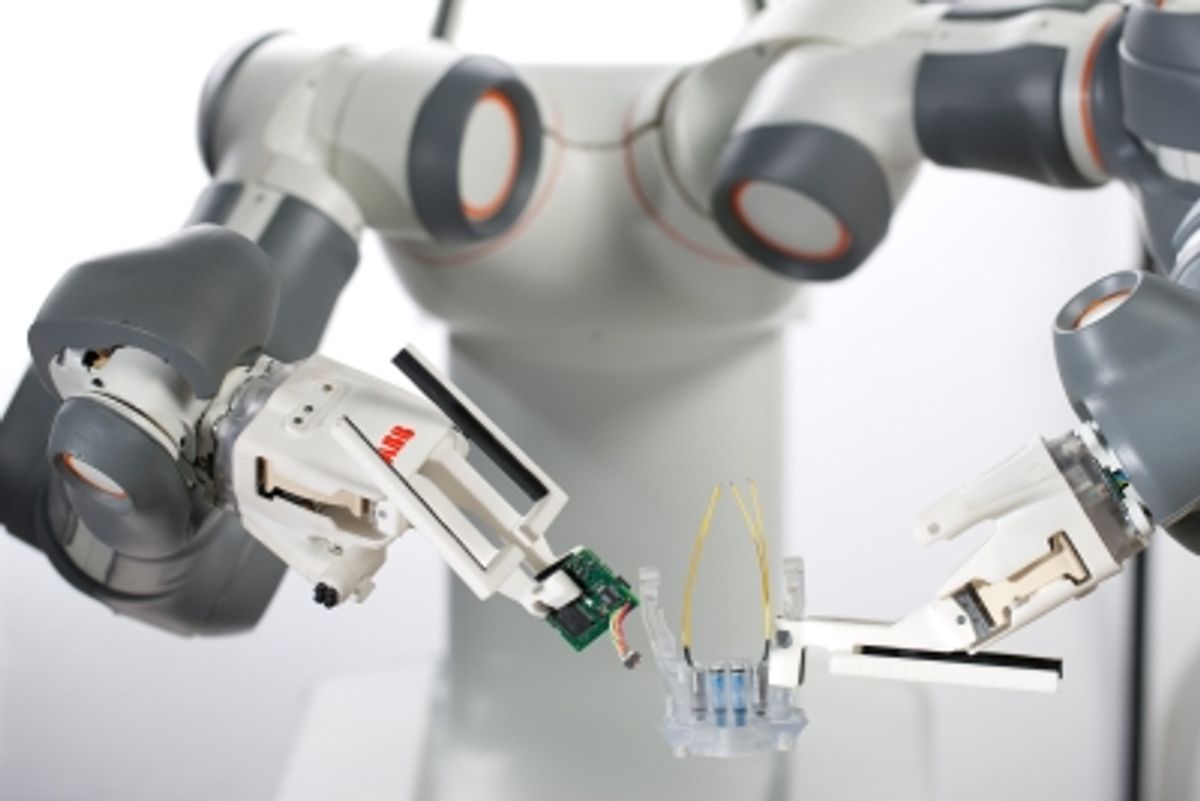This headless, two-armed robot may be tomorrow’s factory worker.
Its name is FRIDA, and it’s a creation of ABB, the Swiss power and automation giant, which introduced it early this month at the Hannover trade show, Europe’s largest industrial fair.
Designed for assembly applications, FRIDA is capable of using its human-like arms to grasp and manipulate electronic components and other small parts. The machine is a concept robot that ABB created to show off its vision for a new kind of industrial robot.
With FRIDA, ABB is the latest among several companies building a new generation of industrial robots that are lighter, safer, more affordable, easier to deploy and reconfigure. Call it industrial robotics 2.0.
FRIDA, which stands for Friendly Robot for Industrial Dual-arm Assembly (you knew an acronym was coming, didn’t you?), is lightweight and compact -- a person can carry it using a handle that comes out at the top. To make it even safer, its motors have limited drive power and soft pads cover its body. The robot has 7-axis arms, each with a servo gripper for small-part handling. Inside the torso is a control system based on ABB’s IRC5 industrial controller.
So what can FRIDA do? One scenario ABB envisions is using it to bring more automation to the fast-paced, and mostly human-powered, assembly lines found in the electronics industry.
Other companies seeking to explore this new market for assembly robots include Motoman, a division of Japan’s Yaskawa, which offers a dual-arm robot called Motoman SDA10D, and the German automation firm pi4_robotics, which early this year unveiled the Workerbot, also a dual-arm robot. Another player, it seems, might be Rodney Brooks’ secretive start-up, Heartland Robotics.
Like FRIDA, the SDA10D and Workerbot are designed for assembly applications, but they are larger than the ABB robot and thus require more safety precautions (for example, fencing or sensor safeguarding) when operating near people.
ABB, like many other robotics companies, insists that its robot isn’t designed to replace human workers, but rather to work alongside them. It says FRIDA fits into spaces used by people and could be “easily interchanged with a human coworker when the production order is changed or a new layout is required.”
The company has built several prototypes and is using them in pilot applications, but it has not provided details about these tests. It hasn’t discussed availability or cost either, emphasizing that FRIDA is a concept. This means that there are two big unknowns about the robot. The first is whether it will be really affordable for companies that would benefit from this kind of robot. The second is whether it will be easy to program the robot to perform assembly tasks. I guess we’ll find out when more details about the robot become available.
What do you think? Is this the beginning of a new era in industrial robotics?
More images:
That’s it. No more work for me.
Images and video: ABB
Erico Guizzo is the Director of Digital Innovation at IEEE Spectrum, and cofounder of the IEEE Robots Guide, an award-winning interactive site about robotics. He oversees the operation, integration, and new feature development for all digital properties and platforms, including the Spectrum website, newsletters, CMS, editorial workflow systems, and analytics and AI tools. An IEEE Member, he is an electrical engineer by training and has a master’s degree in science writing from MIT.








